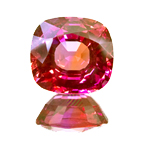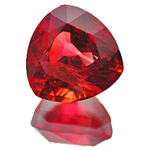Padparaja sapphire
Trade name for pinkish orange or orangish pink sapphire.
Padparaja sapphires belong to the rarest, most sought-after and most expensive sapphires.
Padparaja sapphire shop

Fine padparaja sapphire from the Umba Valley, Tanzania
Origin of name: from the Singhalese word padmaraga, meaning lotus flower
Synonyms and trade names: none. There are, however, different spellings like padparadscha oder padparadja
Can be confused with: there are several other gemstones which may occur in padparaja or padparaja-like colour e.g. topaz (particularly those from Ouro Preto, Brazil), pink beryl (morganite), tourmaline and more.
Identification e.g. via refractive index or specific gravity is usually straightforward.
There are a lot of beryllium-treated sapphire of padparaja colour on the market.
The source material for this treatment is sapphire from Songea, Tanzania. Thus these stones are often sold as "Songea Sapphires", without mentioning the treatment. This is a violation of the gem trade´s code of conduct, as well as of the CIBJO regulations. Beryllium treatment must be declared at the point of sale!

A beryllium-treated sapphire from Songea, Tanzania
Quite often, to find the answer to whether a particular sapphire is a true padparaja or "merely" a pink or orange sapphire, is a bigger problem.
Read more in the "Worth knowing" section further down this page.
Localities: in former times padparaja sapphires were found exclusively in Sri Lanka. Today padparajas also come from Vietnam and Tanzania (Umba Valley).
Handling: due to the great hardness and the absence of cleavage, sapphire generally is easy to work with.
However, sapphires can be heat-sensitive. High temperatures can cause a colour change.
Most corundums have mineral and liquid inclusions. These have higher expansion coefficients than their host. Thus they expand more upon heating which can produce cracks or even total destruction.
Worth knowing: the definition of the padparaja colour is still subject to debate in gemmological circles, as well as in the gem trade.
However, it is agreed that both a yellow/orange and a pink component must be present beyond doubt for a sapphire to qualify as a padparaja.
Which component (pink or orange) should be dominant, is not defined. Thus there are padparajas whose colour is closer to the yellow/orange end of the bandwith, as well as padparajas with a colour closer to pink.
In Sri Lanka the term padparaja is traditionally used for sapphires whose colour resembles the orangish pink of the lotus flower.
Padparaja sapphire shop
 Deutsch
Deutsch